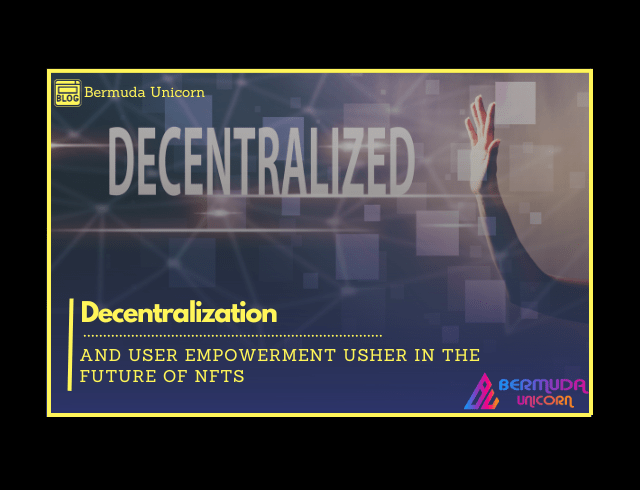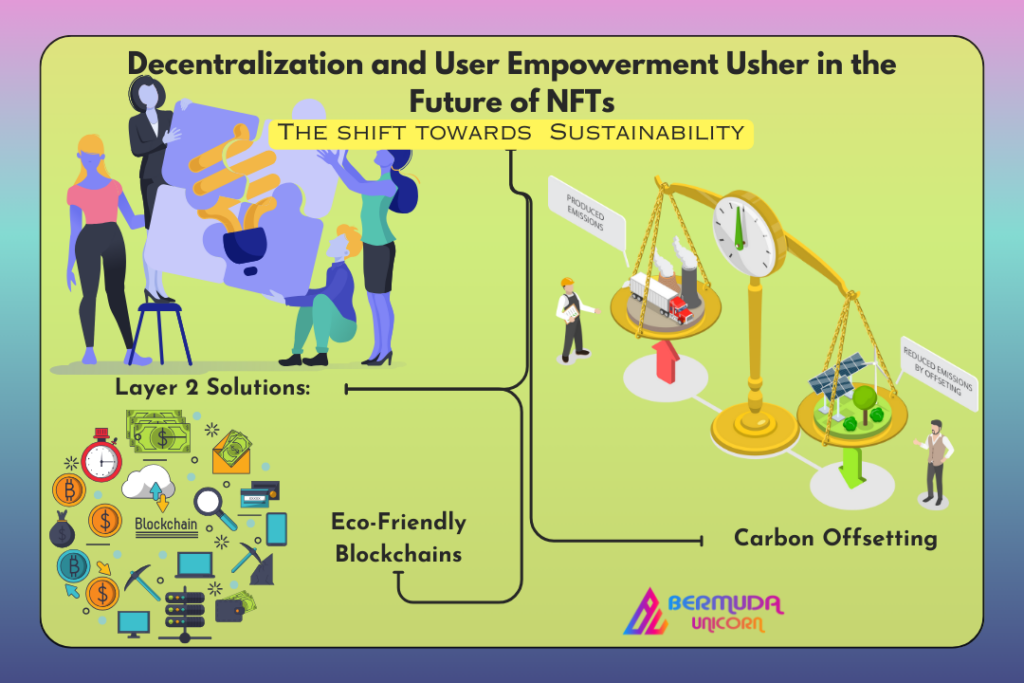![]()

In recent years, Non-Fungible Tokens (NFTs) have emerged as a groundbreaking force reshaping the digital landscape. These unique digital assets, often representing ownership of digital or physical items, have transcended their initial niche in digital art and collectibles to become a global phenomenon. However, the true potential and lasting impact of NFTs are intrinsically tied to the principles of decentralization and user empowerment, which are poised to shape the future of this burgeoning ecosystem. In this extended exploration, we delve deeper into the NFT revolution, the role of decentralization, and its implications for creators, collectors, and the broader digital landscape.
The NFT Revolution: A Recap
Non-fungible tokens (NFTs) have garnered immense attention for their ability to authenticate and represent unique digital assets. Also unlike cryptocurrencies such as Bitcoin or Ethereum, where each unit is interchangeable, NFTs are indivisible and irreplaceable. They derive their value from their scarcity and the transparent, immutable ledger provided by blockchain technology.
The NFT frenzy ignited with digital art and collectibles, allowing artists and creators to monetize their digital works and collectors to acquire one-of-a-kind assets. However, as NFTs expanded into other realms such as music, gaming, and even tweets, questions arose about centralization, environmental sustainability, and user rights.
How Decentralization Empowers Users
1. Ownership and Control:
Decentralized NFT platforms, primarily built on blockchain networks like Ethereum, provide users with absolute ownership and control over their digital assets. Also when you own an NFT, you have complete autonomy over its fate, and no central authority can interfere.
2. Censorship Resistance:
Decentralization ensures that NFTs are censorship-resistant. Once an NFT is minted on a blockchain, it becomes immutable and impervious to any attempts at censorship or alteration. Also preserving the integrity of digital assets and the freedom of creators.

3. Reduced Fees:
Centralized platforms often impose high fees for activities like minting, buying, and selling NFTs. In contrast, decentralized platforms typically offer lower fees, benefitting both creators and collectors by preserving the value of their assets.
4. Interoperability:
Decentralization fosters interoperability between various NFT platforms and ecosystems. Users can seamlessly utilize their NFTs in different virtual worlds, games, and applications without encountering restrictive barriers.
Sustainability in the NFT Space
As NFTs gained prominence, so did concerns about their environmental impact. Many popular blockchain networks used for NFTs, such as Ethereum, rely on energy-intensive proof-of-work consensus mechanisms. The energy consumption of such networks has sparked debates about the carbon footprint of NFTs.
The Shift Towards Sustainability
To address these concerns, the NFT community is actively exploring solutions that reduce the environmental impact of NFTs. This includes:
– Layer 2 Solutions: Layer 2 scaling solutions, such as Ethereum’s transition to Ethereum 2.0 and other blockchains like Tezos, are adopting more energy-efficient consensus mechanisms like proof-of-stake. This shift reduces energy consumption while maintaining the security of the network.
– Carbon Offsetting: Some NFT platforms are implementing carbon offset programs, where a portion of NFT sales goes toward environmental initiatives. This approach aims to mitigate the carbon footprint associated with NFT creation and trading.
– Eco-Friendly Blockchains: Newer blockchain networks are being designed with environmental sustainability in mind. These blockchains prioritize energy efficiency and reduce carbon emissions.

The Expanding Horizons of NFTs
Beyond art and collectibles, NFTs are finding applications in a wide array of industries, including:
Music:
Musicians are releasing NFT albums and exclusive digital collectibles, providing a new revenue stream and closer engagement with fans.
Gaming:
NFTs are revolutionizing the gaming industry, where in-game assets and skins can be tokenized and traded across different games and platforms.
Real Estate:
NFTs are being explored as a means to represent ownership of physical real estate properties, simplifying the process of property transactions.
Virtual Reality:
NFTs enable the creation and ownership of virtual real estate, art, and experiences within virtual worlds, fostering unique user-driven economies.
FAQs
1. What defines a decentralized NFT platform?
A decentralized NFT platform is a digital marketplace or ecosystem that operates on a decentralized blockchain network. It empowers users to create, trade, and own NFTs without relying on a central authority or intermediary.
2. How can I verify the authenticity of an NFT on a decentralized platform?
Decentralized platforms leverage blockchain technology to confirm the authenticity of NFTs. You can trace an NFT’s ownership and provenance on the blockchain, ensuring its legitimacy.
3. Are decentralized NFT platforms more environmentally sustainable than centralized ones?
Many decentralized NFT platforms operate on eco-friendly blockchains or employ energy-efficient consensus mechanisms, contributing to a smaller carbon footprint compared to some centralized platforms.
4. Can I still use centralized platforms to sell my NFTs if I prefer them?
Yes, you retain the option to sell your NFTs on centralized platforms if they align with your preferences. Many creators opt for a hybrid approach, utilizing both centralized and decentralized platforms to maximize their reach.
5. What does the future hold for NFTs and decentralization?
The future of NFTs is intricately linked with decentralization and sustainability. As demand grows for ownership, control, and sustainability, decentralized NFT platforms will continue to evolve and play a pivotal role in shaping the NFT landscape.
Embracing the Future
In conclusion, decentralization and user empowerment are catalyzing the transformation of NFTs, propelling them into a more sustainable, inclusive, and user-centric future. As the NFT ecosystem matures, it becomes increasingly vital to prioritize user rights, ownership, and sustainability to ensure the long-term success and positive impact of this transformative technology. The journey ahead promises continued innovation and evolution, offering exciting prospects for creators, collectors, and all participants in the NFT revolution.
